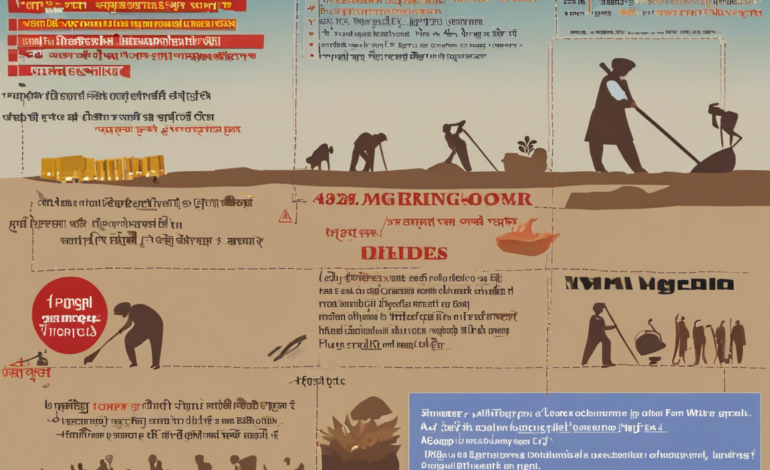Decoding MGNREGA: Understanding the Scheme in Detail.

The Mahatma Gandhi National Rural Employment Guarantee Act (MGNREGA) is one of the most significant social safety nets in India. Enacted in 2005, the scheme guarantees 100 days of wage employment in a financial year to every rural household whose adult members volunteer to do unskilled manual work. MGNREGA aims to enhance livelihood security in rural areas by providing wage employment, preventing distress migration, and creating sustainable rural infrastructure.
Understanding MGNREGA Objectives
The primary objective of MGNREGA is to enhance the livelihood security of rural households by providing at least 100 days of guaranteed wage employment in a financial year. The scheme also aims to create durable assets and improve the quality of life in rural areas. Some of the key objectives include:
1. Employment Generation
MGNREGA provides a safety net to rural households by ensuring wage employment opportunities when they need it the most. This helps in reducing poverty and improving the standard of living of rural families.
2. Asset Creation
The scheme focuses on creating productive assets such as water conservation structures, rural roads, and irrigation facilities. These assets not only provide employment but also contribute to long-term development and sustainability in rural areas.
3. Sustainable Development
MGNREGA emphasizes the inclusive growth of rural areas by promoting sustainable development practices. It aims to empower communities and enhance their resilience to economic shocks.
Implementation of MGNREGA
MGNREGA is implemented by gram panchayats in partnership with state governments. The process involves various stages, including:
1. Registration
Rural households can apply for job cards at the local panchayat office. Once registered, they can demand employment under the scheme.
2. Work Allocation
The gram panchayat is responsible for allocating work to job cardholders based on demand and priority. The works undertaken should be within the unskilled manual labor category.
3. Payment of Wages
Wages are paid directly to the workers’ bank accounts within 15 days of completion of work. The payment details are also displayed at the worksite and accessible to the public.
4. Social Audit
MGNREGA mandates social audits to ensure transparency and accountability in the implementation of the scheme. Social audits involve the participation of local communities in monitoring and evaluating the works undertaken.
Benefits of MGNREGA
1. Poverty Alleviation
MGNREGA plays a crucial role in alleviating poverty by providing employment and income support to rural households, especially during agricultural off-seasons.
2. Gender Empowerment
The scheme promotes gender equality by ensuring that at least one-third of the beneficiaries are women. It empowers women to participate in economic activities and decision-making processes.
3. Infrastructure Development
MGNREGA contributes to creating rural infrastructure assets such as roads, ponds, and check dams, which are essential for improving connectivity and water conservation.
4. Sustainable Agriculture
The scheme supports activities like water conservation, afforestation, and land development, promoting sustainable agricultural practices in rural areas.
Challenges Faced by MGNREGA
While MGNREGA has been instrumental in providing livelihood security to millions of rural households, it also faces several challenges:
1. Delay in Wage Payments
Delayed wage payments impact the livelihoods of beneficiaries and deter them from actively participating in the scheme.
2. Lack of Awareness
Many eligible households are unaware of their rights under MGNREGA, leading to underutilization of the scheme.
3. Administrative Bottlenecks
Administrative inefficiencies at the grassroots level often hinder the smooth implementation of the scheme.
Frequently Asked Questions (FAQs) about MGNREGA
1. What is the eligibility criteria for MGNREGA?
To be eligible for MGNREGA, a household must reside in a rural area and be willing to undertake unskilled manual work.
2. How can I apply for MGNREGA job card?
You can apply for a job card at your local gram panchayat office by submitting the required documents.
3. Is there a minimum age requirement for MGNREGA employment?
There is no minimum age requirement for MGNREGA employment, but individuals must be willing and capable of performing unskilled manual work.
4. Can I demand work under MGNREGA anytime during the year?
Yes, eligible households can demand work under MGNREGA at any time during the year, subject to the availability of funds and work projects.
5. How are wages calculated under MGNREGA?
Wages under MGNREGA are calculated based on the prevailing wage rate in the state, as notified by the government from time to time.
6. Are there any penalties for non-payment of wages under MGNREGA?
Yes, there are penalties for delayed payment of wages under MGNREGA to ensure timely disbursal of funds to beneficiaries.
7. How can I participate in the social audit of MGNREGA works?
You can participate in the social audit process by engaging with local civil society organizations or attending public hearings conducted by the gram panchayat.
8. Can MGNREGA funds be used for any other purposes?
MGNREGA funds are meant to be used exclusively for implementing works under the scheme and cannot be diverted for any other purposes.
9. Is there a limit to the number of days a household can work under MGNREGA?
MGNREGA guarantees at least 100 days of wage employment in a financial year per household, but additional days of work may be provided subject to the availability of funds.
10. How does MGNREGA contribute to rural development?
MGNREGA contributes to rural development by creating productive assets, enhancing livelihood security, and promoting sustainable agricultural practices in rural areas.
In conclusion, MGNREGA serves as a crucial pillar of social welfare in India, providing rural households with a safety net and contributing to sustainable development. While the scheme faces challenges, its impact on poverty alleviation, infrastructure development, and gender empowerment cannot be overstated. Continued government support, community participation, and effective monitoring are essential to ensure the successful implementation of MGNREGA and maximize its benefits for rural communities.


